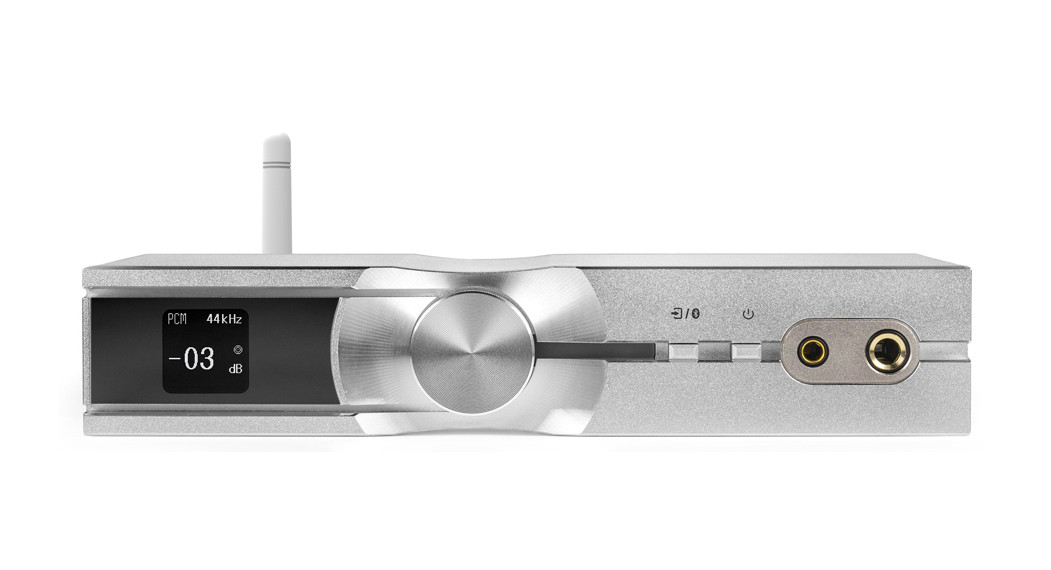DAC/HEADPHONE AMPiFi Audio NEO iDSD

Launched with a typically dazzling array of acronyms, the NEO iDSD is nonetheless a more focused DAC/pre/headphone amp, equipped with the latest ‘hi-res’ Bluetooth Review: Andrew Everard Lab: Paul Miller
Seemingly there’s no stopping Southport-based iFi Audio: it just keeps on trotting out new digital products, all aiming to fill a gap in the market – or create a new gap to fill. Indeed, while writing this review I was unsurprised to see another new launch pop up, in the form of the bright red iDSD Diablo [see News, p22]. The £699 NEO iDSD featured here, however, comes from a different strand of the company’s offering, slotting in well below the £2499 flagship Pro iDSD [HFN Sep ’18] in the desktop DAC/headphone amp/preamp market. It may be little more than a quarter the price of that range-topper, lacking its switchable valve/solid-state output stage and digital filters, but it doesn’t take long to discover the NEO iDSD is a highly appealing component, whether used on the desktop to drive headphones or slotted into a full-on hi-fi system. Packed into its slender form is not just a DAC/headphone amp configuration, of the kind the company is rolling out across most of its products, but also the choice of balanced XLR and single-ended RCA line/ preamp outputs. And while it’s not as tiny as some of its Audio’s offerings, the NEO iDSD is still compact – just 21.4cm wide and a shade over 4cm tall – and has the usual sense of quality and precision about its build that’s a hallmark of the brand.
NEAT FEATURE
What’s more, for those planning a life on the desktop for their new acquisition, it comes with a little stand, made of the same high-quality aluminum as the NEO iDSD’s casework, allowing the unit to be stood on end, thus giving it a space-saving footprint. Do that, and the OLED display – which covers file format, sample rate, input selection, and volume – rotates 90 to the correct orientation. OK, we’ve already
RIGHT: Optimised layout with Qualcomm QCC5100 Bluetooth [far right] and XMOS USB hub [centre] feeding a Burr-Brown DSD1793 DAC [above] and IC op-amp-based balanced line [lower left] and headphone [upper left] outputs
seen this on hi-fi products from the Denon Design series and latest compact NAD amplifiers [HFN May ’18], and of course,re-orientating displays have long been taken for granted on smartphones and tablets, but it’s still a neat feature.The NEO iDSD’s input provision and format compatibility ensure wide-ranging flexibility: coaxial and optical digital ins are provided, along with a ‘stacked’ USB-B port for connection to a computer. There are Windows drivers available for download from the fire Audio website, but none are needed for Mac or Linux. In addition, there’s Bluetooth wireless connectivity, described by the manufacturer as ‘bleeding-edge (but then there’s a lot of such language in the publicity material) in its application of the latest Qualcomm QCC5100 module. This chipset handles not just AAC/SBC/ aptX and aptX HD, but also aptX Adaptive, aptX LL, the LDAC format used by Sony devices, and Huawei’s HWA/LHDC. In other words, if your portable device can output hi-res audio wirelessly, then the NEO iDSD will be sure to accept it.
POWER UPGRADE
Otherwise, the highest resolutions are only possible over the NEO iDSD‘s USB-B connection, extending to 768kHz/32-bit PCM and DSD512, thanks to the Burr-Brown DSD1793 DAC, which is already widely used across the iFi Audio range. The
NEO iDSD also offers MQA decoding, but the digital implementation here is simpler than that in, say, the Pro iDSD, with the latter’s various filter and upsampling options left out here in the cause of simplicity, and economy.
Meanwhile, the front-panel headphone outputs, which run to a standard 6.35mm unbalanced socket, and 4.4mm Pentaconn for balanced working, are fed via a digitally governed ‘analog’ volume control, as are the variable-level line outputs. This single rotary on the NEO iDSD also combines with the two little buttons on the fascia – for input selection/Bluetooth pairing
‘It’s shorn of much of the faffing about – sorry, flexibility’

and power – to also switch between fixed and variable mode, mute the output, and adjust the brightness of the display. Finally, the NEO iDSD comes with iFi Audio’s 5V power plug top supply, with the option of upgrading to the company’s £99 iPower X.
 POWER PLAY
POWER PLAY
In operation, this DAC/headphone amp swiftly reveals two things – one is that it’s exceptionally simple to use, shorn as it is of much of the faffing about – sorry, flexibility. Just hook it up, and it works. In our review of the flagship Pro iDSD, I commented that ‘this is one of those “need to know what you’re doing” products – there’s no fast or easy way to get the most out of it, and some aspects of its set-up need work’. The NEO iDSD is much more of a ‘plug and play’ prospect, and even without a direct comparison with the range-topper, it’s clear this newer, and much more keenlypricedmodel sounds very good indeed, whether used with high-quality ’phones or connected into the main system. I tried it as a desktop system, feeding a range of headphones encompassing various technologies from planar magnetic to moving-coil, with both balanced and unbalanced connections, and also fed its unbalanced outputs in fixed-level mode into the inputs on my NaimUniti/Neat Iota desk system, fed from my 2020 Mac mini computer. Meanwhile, in my main system it was used in both line and variable output modes to good effect, again fed from another Mac mini. Both computers were controlled using Roon, and operated by the Roon app on an iPad, with music sourced from my NAS library in a variety of formats right up to the NEO iDSD’s limits. I also explored a range of files streamed wirelessly over Bluetooth from Apple and Samsung phones with impressive results. I’m still not sure I’d choose a phone and the NEO iDSD as my only means of playing music, but at least the set-up proved both viable and musically enjoyable. Used with headphones including my tried-and-tested Oppo PM-1 [HFN Jul ’14] and Focal Spirit Pro [HFN Dec ’15], as well
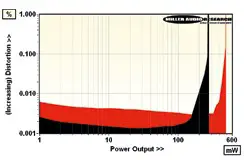
IFI’S EDGE
Although the NEO iDSD plays second-fiddle to iFi Audio’s costlier Pro iDSD model which offers a higher 450mW/32ohm output [HFN Sep ’18], the more affordable newcomer harbors a couple of very useful performance advantages. Sure, the maximum single-ended headphone output is 3.25V versus 4.2V for the Pro iDSD, and the power output is a little lower too at 269mW/32ohm [black trace, inset Graph]. The headphone output also clips at full ‘0dB’ volume with a maximum 0dBFs digital input, so ‘–1dB’ should be your maximum setting, and this with the least sensitive headphones available should you value your hearing… The advantage offered by the NEO iDSD comes with its better voltage/current balance, the latter is able to support a full 486mW into the very lowest 8ohm loads at 1% THD [red trace, inset Graph]. The second improvement offered by the NEO iDSD comes in the form of its low 300mohm (0.3ohm) source impedance which minimizes signal loss and also renders its response largely immune to the variations in headphone load. By default its response mirrors that of the line outputs [see Lab Report, p75] while, importantly, residual noise is suppressed and the A-wtd S/N extremely wide at 107dB, so hiss and hum will still be low with sensitive headphones. PM
ABOVE: The OLED display indicates audio format, sample rate, input, and volume, with the rotary, also used to set brightness and mute. Single-ended 6.35mm and balanced 4.4mm Pentaconn headphone sockets are included,
as B&W’s P9 Signature [HFN Mar ’17] and Philips Fidelio X3, it was clear that this unit offers excellent clarity, and more than enough power to drive even demanding loads to levels way beyond wise or sensible while retaining poise and dynamics. It also showed the benefits in terms of grip and resolution of balanced headphones working with the Oppo and Philips ’phones, though not without a spot of scrabbling through my ‘adapters box’ to find connectors to hook up that 4.4mm Pentaconn to 2.5mm plugs, four-pin XLRs and more. I want to make a plea for some standardization for balanced headphone connections, as we have with the 3.5/6.35mm connector for unbalanced working. I have found balanced operation to be worthwhile when headphones offer it, but getting the right connectors will make you
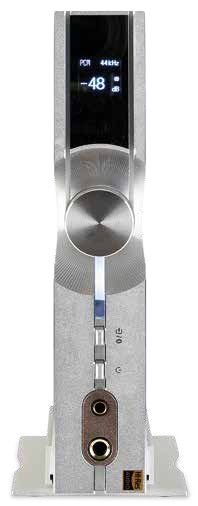
RIGHT: The NEO iDSD can be set vertically onto a supplied aluminum stand – the display flips through 90º

ABOVE: Digital inputs are shared across coaxial, optical, and USB-B sockets alongside wireless Bluetooth 5.0. Balanced (XLR) and single-ended (RCA) analog outputs may be configured for fixed or variable operation, the latter offering higher output
a valued customer of many an accessory vendor! Anyway, the iFi NEO iDSD certainly makes a strong case for using a dedicated headphone amp rather than just the socket on your amplifier. Playing a set such as a bassist Brian Torff’s live Manhattan Hoedown [now remastered on 2XHDJA1192; DSD128] the speed and definition apparent on his subtle, precise playing of the upright bass is thrilling, as is the interplay with pianist Jim Roberts. And when you change tack to a recording with really low electronic bass, such as Jean-Michel Jarre’s Welcome To The Other Side ‘virtual concert’ [Sony; 48kHz/24-bit download], the NEO iDSD’s combination of attack, detail, and sheer weight is striking right from the dramatic opening chords.
REAL FUNIt even proceeds to control the weighty-sounding B&W headphones to deliver taut rhythms as it slams into ‘Oxygene 2’, with those panning effects J-MJ seems to love so much. So, yes, this compact unit will drive hard and clean when required, to the extent that some caution is suggested [see PM’s boxout, p73] before you get too carried away with your headphone levels. However, it’s also all about detail and refinement, as is clear with the glorious recent Pittsburgh
LEFT: Flat and compact remote governs input selection, volume, mute and display brightness
Symphony Orchestra/Manfred Honeck recording of Beethoven’s 9th [Fresh!/Reference Recordings, FR-741; 192kHz/24-bit], which mixes that massive scale with the finest of touches in the instrumental timbres as it builds to its great choral climax.The job was done on the headphone front, then, but the NEO iDSD also delivers when used in the system rack, whether at line-level into a conventional amp or preamp or straight into power amplification. I had real fun with it both into my main system and also feeding a pair of elderly Marantz MA-22 monoblocks driving my Neat Iota Xplorer speakers [HFN Jul ’18]. In this context, the credit card’ remote iFi Audio supplies [see below] completed this somewhat eccentric but engaging ‘small but perfectly formed’ system. In practice, it went on to power out everything from Eva Zaïcik’s exuberant Royal Handel recital [Alpha Classics ALPHA 662; 192kHz/24-bit], with a glorious balance between voice and the accompaniment of Le Consort, to The Foo Fighters’ slamming Medicine At Midnight set [RCA 978836] with the right mix of control and snarl.
HI-FI NEWS VERDICT
Whether you need a high-quality desktop audio/head-fi solution, or a slimline DAC to slot into your main system – or both – the NEO iDSD has much to commend it, from its powerful, weighty, and controlled sound to its broad file format compatibility. Yes, it lacks some of the digital set-up options available elsewhere, instead of going for a much more ‘plug and play’ approach, but then do you want to fiddle, or listen?
LAB REPORT
IFI AUDIO NEO IDSDWith a peak level (0dBFs) digital input the NEO iDSD clips at full volume so, in practice, the maximum variable output via the balanced XLRs is 5.6V with the volume at ‘–1dB’. This is still substantial and more than sufficient to drive any power amplifier, aided by a moderate 50ohm source impedance and wide 110dB A-wtd S/N ratio. Hand-in-hand with this low noise comes excellent low-level linearity, the single DSD1793 DAC achieving a resolution of ±0.2dB over a full 100dB dynamic range. The fixed (balanced) the volume setting is not far behind, yielding a maximum 4.28V output (re. 0dBFs) at 0.0012-0.0045% distortion, falling to a minimum of 0.00014-0.0002% at –20dBFs [see Graph 1, below]. While the latter is impressive, the cloud of low-level sidebands detected on the jitter tests was unexpected[see Graph 2, below]. This complex pattern has sidebands at ±33Hz, ±66Hz, ±99Hz, etc, amounting to some 550psec – not debilitating by any means but atypical of iFi Audio’s latest form. For this stripped-down DAC, iFi Audio makes a feature of its minimalism, eschewing the switchable digital filters that are included in its costlier Pro iDSD model [HFN Sep ’18]. By default, the NEO iDSD comes with iFi Audio’s GTO (Gibbs Transient Optimised) digital filter, although alternative algorithms can be loaded as firmware updates if preferred. On test, this looks like a limited-tap linear phase filter offering a balance between a modest 53dB stopband rejection, symmetrical pre/post ripples in the time domain and extended response that’s flat to –0.14dB/20kHz, –0.8dB/45kHz, and –2.6dB/90kHz (48kHz, 96kHz, and 192kHz media, respectively). The performance of the headphone amplifier largely follows suit – sharing the same digital front-end [see boxout, p73]. PM
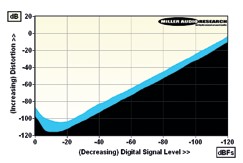
ABOVE: Distortion versus 48kHz/24-bit digital level over a 120dB range (1kHz, black; 20kHz, blue)
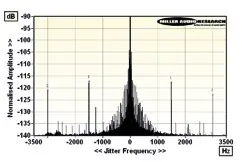 ABOVE: High-resolution 48kHz/24-bit jitter spectrum revealing low-level, low-rate 33Hz sidebands
ABOVE: High-resolution 48kHz/24-bit jitter spectrum revealing low-level, low-rate 33Hz sidebands
| Max output/Imp. (<1% THD, DAC) | 5.60Vrms / 50ohm (balanced) |
| Maximum output (headphone) | 3.25V/600ohm / 269mW/32ohm |
| Headphone Output Imp. (20Hz-20kHz) | 0.24-0.75ohm (single-ended) |
| A-wtd S/N ratio (DAC / headphone) | 109.5dB / 107.5dB |
| Distortion (20Hz-20kHz, DAC/headph.) | 0.0012-0.0045% / 0.005-0.048% |
| Freq. resp. (20kHz/45kHz/90kHz, DAC) | +0.0 to –0.14dB/–0.8dB/–2.6dB |
| Digital jitter (48kHz / 96kHz, DAC) | 550psec / 555psec |
| Power consumption | 3W |
| Dimensions (WHD) / Weight | 214x41x146mm / 1kg |
USB DAC/headphone preampMade by: iFi Audio (Abbingdon Global Group), MerseysideSupplied by: iFi AudioTelephone: 01900 601954Web: www.ifi-audio.comPrice: £699
References
[xyz-ips snippet=”download-snippet”]

